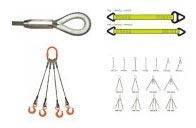Nylon slings, which are also commonly called nylon web slings, are highly prized by those in the manufacturing and lifting industry. They are made of a strong and dense, web-like construction. The flexibility of nylon slings makes them ideal for delicate equipment that needs to be handled carefully.
A nylon sling stretched between 6 and 8% of its total length, which means they are not suitable for all applications. Nylon also is absorbent, which means acids affect the strength of the material. Industrial-grade webbing, with a rating of 9,800 pounds per inch, is available for heavy lifting applications.
To get the most from nylon slings, you need to follow the below strap maintenance tips:
Proper Use
Never overload the sling and never use it while it is unbalanced. As the sling angle decreases, each leg's load will increase, which puts unnecessary stress on slings.
Visual Inspections
Before using nylon slings, you should first visually inspect the fabric to look for abrasions or foreign matter. You only want to work with clean and functional slings.
UV Rays & Temperature
Extreme weather and intense UV light can stiffen and bleach lifting straps. Nylon begins to degrade when exceeding temperatures of 194°F. Keeping your gear safe from extended exposure to the sun and inclement weather extends the product's life.
Wire Rope